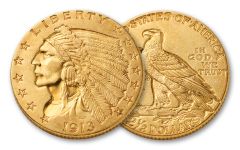Local Storage seems to be disabled in your browser.
For the best experience on our site, be sure to turn on Local Storage in your browser.
Gold Indian
Indian Head gold coins began a renaissance in American coinage, transforming U.S. gold coins into works of art. These beautiful gold coins range in denominations from the Indian Princess dollar, to $2.50 Quarter Eagle, $3 Princess, $5 Half Eagle, and $10 gold Eagle. This series depicts Native American Indians struck in gold in celebration of the rich cultural history of the United States. Collectors have found pre-1933 Gold Indian Head coins very desirable. The Indian Head designs were promoted by President Theodore Roosevelt, and minted until 1933 when President Franklin Roosevelt required Americans to turn in their Gold coins to be melted into bars to help combat the Great Depression.
Today, Indian Head Gold are considered to be among the most beautiful U.S. gold coins minted by the Government. These signature coins celebrate America’s dramatic transformation into the leading power of the 20th century. Today, there are a relatively small number of Indian Series gold coins that still exist, however there is ample inventory to shop through to find the Gold Indian Coin that is just right for you.
The First Designs
The first Indian designs came after the massive amounts of gold emerged from the California Gold Rush. Congress authorized three new denominations; the gold dollar, three-dollar gold piece and a $20 Double Eagle. In 1854, the then U.S. Mint’s Chief Sculptor-Engraver, James Barton Longacre, designed the Indian Princess dollar and $3 Indian Princess gold piece. Faced with the task of designing a new coin that was completely different from the existing Quarter Eagle and Half Eagle Liberty gold, Longacre accomplished the challenge with his innovative Indian Princess design. Longacre’s Indian Princess Dollar design features Liberty wearing a feathered headdress, believed to be based from a Roman marble sculpture of the Venus Accroupie or Crouching Venus, which was on display in a Philadelphia museum at the time. Longacre’s $3 Indian Princess stands apart from any other coins produced by the U.S. Mint as the only $3 coin ever issued and beginning of the Indian design. The $3 gold was the shortest-lived gold coin denomination circulating for only 36 years.
U.S Coinage Renaissance
The Indian Head design for the gold $2.50 Quarter Eagle, $5 Half Eagle, and $10 gold Eagle were inspired by President Theodore Roosevelt who felt our coins at that time had become very bland, and he wanted our coinage to reflect our Nation's pre-eminent status and preferred a high-relief design similar to ancient Greek coinage. President Roosevelt encouraged famed sculptor Augustus Saint-Gaudens to redesign America’s gold coinage into works of art. The $20 Double Eagle and $10 Eagle Indian Head were the last works of art for the dying artist. When the stunning new coins debuted in 1907 to rave reviews just after St. Gaudens death, he then gave his personal blessing to have former St. Gaudens student, Bela Lyon Pratt, redesign the two remaining gold coins the following year. The $2.50 Quarter Eagle and the gold $5 Half Eagle Indian Head gold coins were Pratt's designs. Pratt moved away from the symbolic Liberty design and replaced it with a bold American Indian design, which earned him great praise. The two small gold Indians were different than any other coin struck by the U.S. Mint. Normally, coin designs are raised above the flat field, however, on these coins, the design is impressed into the metal and is lower than the field, known as an incuse design. This fascinating technique has never been used on the entirety of any of the other U.S. coins, and stand out from all other United States coins. Nonetheless, these designs from St. Gaudens and Pratt would endure on American Gold coins until the ending year of gold coinage in 1933.
Indian Head Quarter Eagle
Indian Head Quarter Eagle was minted for a brief 13 years beginning in 1908, the $2.50 Indian is one of the shortest-lived series in U.S. numismatics. It was issued annually from 1908 through 1915, at which point the mint suspended its production for a decade because of World War I. Minting resumed after the war in 1925, and continued for an additional five years before ending in 1929 due to the Wall Street crash and beginning of the Great Depression.
The $5 Gold Indian Head Half Eagle
The $5 Gold Indian Head Half Eagles were struck from 1908 to 1916, with a large gap between 1917 and 1928, and issued again for one last year in 1929. These issues are attractive to collectors because they have a unique combination of rarity, beauty, and gold value, with the historical significance of the early 20th Century.


